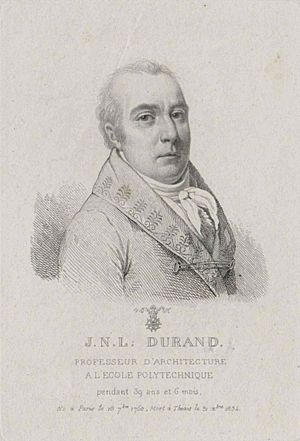Jean-Nicolas-Louis Durand facts for kids
Jean-Nicolas-Louis Durand (born in Paris, France, on September 18, 1760 – died in Thiais, France, on December 31, 1834) was a very important French architect, writer, and teacher. He played a big part in a style of architecture called Neoclassicism. He also came up with a clever way to design buildings using simple, interchangeable parts. This idea was so ahead of its time that it helped shape how modern buildings are put together today, almost like giant LEGO sets!
Contents
Who Was Jean-Nicolas-Louis Durand?
Jean-Nicolas-Louis Durand started his career working with famous people. He learned a lot from a well-known architect named Étienne-Louis Boullée. He also worked with a civil engineer, Jean-Rodolphe Perronet. These experiences helped him develop his own unique ideas about building design.
A New Way to Design Buildings
Durand was a key figure in the Neoclassical movement. This style of architecture looked back to the simple, grand designs of ancient Greece and Rome. Think of buildings with lots of columns and clear, balanced shapes. But Durand took this a step further. He believed that buildings should be designed using simple, standard pieces. Imagine having a set of building blocks that you could combine in many different ways to create all sorts of structures. This idea of "modular elements" made building design more efficient and easier to repeat. It was a bit like creating a kit for buildings.
Teaching the Next Generation
In 1795, Durand became a Professor of Architecture at the famous École Polytechnique. This was a big deal! He taught many future architects his ideas about simple, logical design. He wrote books that explained his methods, showing how to plan buildings in a clear and organized way. His teaching helped spread his ideas far and wide, influencing many students who would go on to design important buildings themselves.
Why He's Still Important Today
Durand's ideas about using simple, modular parts were revolutionary. They were so advanced that they predicted how buildings would be made much later, during the time of modern factories and mass production. His work helped pave the way for today's industrialized building methods, where parts are often made in factories and then put together on site. He showed that good design could be both beautiful and practical, using clear rules and simple shapes.
See also
 In Spanish: Jean Nicolas Louis Durand para niños
In Spanish: Jean Nicolas Louis Durand para niños
- Étienne-Louis Boullée
- Leo von Klenze
- Gustav Vorherr
- Friedrich Weinbrenner


